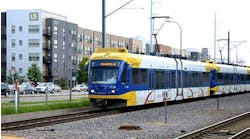Bombardier Transportation is demonstrating its latest innovative European Rail Traffic Management System (ERTMS) regional solution during a day-long field trip as part of the UIC ERTMS World Conference. The visit to the Västerdal line in Western Sweden will provide delegates with the opportunity to view the groundbreaking Bombardier Interflo 550 ERTMS regional system on site. This is the first global application of the new International Union of Railways (UIC) rail control specification for lower traffic routes, commissioned earlier this spring.
As co-organisers of the event, Bombardier and the Swedish Transport Administration will host delegates on a technical visit of a section of the Borlänge to Malung line, located 250 km northwest of Stockholm. Participants will travel on the line to experience the innovative solution in operation and participate in simulations of the ERTMS regional implementation for Sweden as well as Bombardier’s onboard technology. There will also be a presentation on the experience gained from the project and its implementation on the Västerdal line.
In addition, Bombardier will present its vision for the future of this new technology and its global application as part of the conference’s technical seminar programme on April 26. During the two-day event, Bombardier will display its global solutions and portfolio in the exhibition area.
The new Interflo 550 ERTMS regional system reduces operational costs and accommodates increased traffic capacity and automated train control around the clock. It presents a sustainable alternative for lines otherwise burdened with the cost of maintaining manual operation or upgrading to traditional remote-controlled signalling. The innovative solution combines the ERTMS standard for onboard automatic train protection (ATP) with a radio-based wayside system, thereby minimising trackside equipment.
Peter Cedervall, president, Rail Control Solutions, Bombardier Transportation said: “This first regional application is an important milestone for the rail industry with Bombardier again at the heart of rail control innovation. Our product offers significant benefits and is suitable for application worldwide, forming an important part of Bombardier’s global range of ERTMS solutions presented during the conference. We are very pleased that the first implementation can be demonstrated in Sweden, as part of this event.”
Bombardier Transportation’s Rail Control Solutions portfolio covers the whole range of Bombardier Cityflo mass transit solutions, from manual to fully automatic, as well as communications-based systems. It also provides Interflo mainline solutions, from conventional to ERTMS Level 2 systems. Bombardier provides a complete palette of wayside and onboard signalling products.
Bombardier has a long and distinguished history in railway signalling operations in Sweden and comprehensively understands the market. Its Rail Control Solutions Research & Product Development Team based in Sweden, supported by highly skilled engineers in Denmark, Finland and Norway, offers solutions that directly address customer requirements. This is combined with more than 100 years’ experience of developing, engineering and installing advanced signalling technology that underpins rail traffic flow worldwide.
Many respected customers in Sweden have trusted Bombardier to implement significant breakthrough contracts. As well as delivering its ERTMS regional systems for further lines in Sweden, Bombardier is implementing ERTMS Level 2 systems for the Botnia line (in operation) and Ådals line as well as the development of onboard equipment as part of the extensive ERTMS roll-out programme in Scandinavia. Bombardier was also chosen to supply its Interflo 250 solution on the 15 km Öresund bridge connecting Sweden and Denmark, supporting up to 200 trains passing every day.



